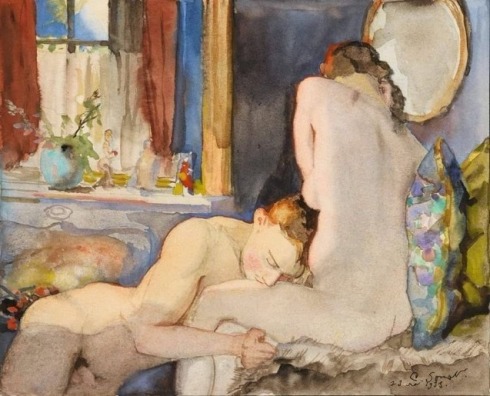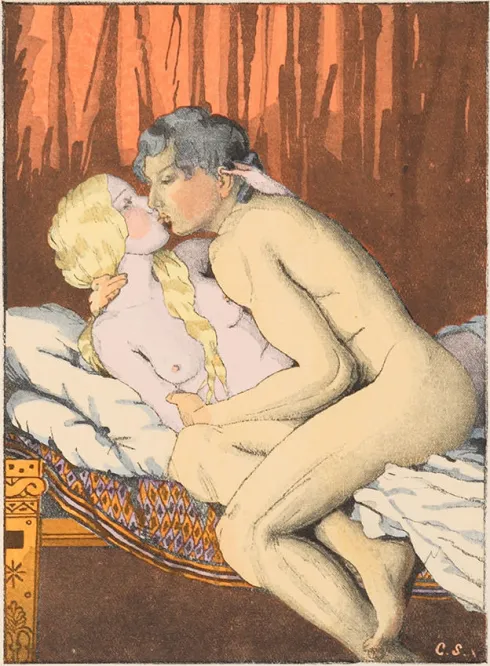 Konstantin Somov, The Lovers, 1933
Konstantin Somov, The Lovers, 1933
“I could have drowned in those so-called dreams”
(Tindersticks, Rented Rooms)
I have been tremendously interested in the paintings of the Russian painter Konstantin Somov the whole of last year and still his work holds a spell over me mainly because he so often paints lovers and because of the escapist, nostalgic tendencies that he exhibits in paintings parties and park scenes with obvious hints to the paintings of Antoine Watteau and Rococo in general. Love, pleasure and the eighteenth century; who can resist!? And yet, what I like about his watercolours of lovers such as the one above, “The Lovers”, from 1933 is its simplicity, rawness and intimacy. While his eighteenth-century inspired paintings have an air of glamour, fun and slight decadence to them, these kind of watercolours are pure in that they depict a genuine emotion, a softness and tenderness between lovers which doesn’t seem like a scene from a comedy. It is more as if we are peeking through the keyhole and witnessing what we ought not to be witnessing. The fact that it was set in that time and not in some idealised past era also brings this sense of intimacy and immediacy. The poses of the lovers are not theatrical as his eighteenth-century depictions of lovers often are, but tender; the man is laying his head in the lap of the women, perhaps the safest place in the world for him, a flowery meadow of calmness and inspiration. One of her bosom is touching his head, but her head is turned away, she seems shy, or closed-off perhaps, or maybe I am reading too much into it. The other elements in the watercolour; the mirror, cushions, flowers on the windowsill, opened window, all brings a sense of domesticity and joy. The medium of watercolours truly fits the gentle mood of the scene.
The watercolour made me think of Tinderstick’s song “Rented Rooms” from their album “Curtains” (1997) which is about lovers stealing time to be together, rushing to all the secretive places where they can give in to their intimate urges. The relationship in the song is one characterised by a sense of impermanence, restlessness and instability, and not of the exciting kind because the lovers have a deep desire to connect but the physical union alone leaves them feeling again restless and yearning for more. Especially the lines “We can’t afford the time to sit and cry or to wonder why…” makes me think of this watercolour because lovers are always in a frenzy, with so many kisses yet to happen, who has time to sit and think about things!? In Somov’s another watercolour, “Daphnis and Chloe”, painted in 1931 and shown bellow, we again see the lovers tenderly depicted, though there is more of an erotic touch here for sure; the man is holding the woman around the waist and closing her eager-to-chit-chat lips with a kiss until they sink down in a bed of dreams. The woman’s rosy cheeks and her golden hair cascading down her neck and breasts give her a doll-like, elegant appearance.

Konstantin Somov, Daphis and Chloe, 1931, watercolour







